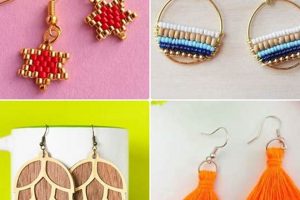The concept involves modifying pre-existing shirts through various cutting techniques to achieve unique aesthetic designs. These modifications range from simple alterations, such as cropping or creating distressed effects, to more complex transformations involving intricate patterns and restructured silhouettes. An illustrative example includes transforming a basic t-shirt into a halter top through strategic removal of fabric and re-tying.
The practice holds significance due to its affordability, promoting resourcefulness by repurposing existing garments and reducing textile waste. Historically, this type of clothing modification has been associated with counter-culture movements and individualistic expression, offering a tangible means to personalize attire beyond mainstream fashion trends. The inherent adaptability of the method enables exploration of diverse styles and customization options unavailable through conventional retail channels.
The subsequent discussion will examine specific techniques employed in shirt alteration, including considerations for fabric type, tool selection, and design implementation. Detailed guidance will be provided on achieving particular visual effects and addressing potential challenges in the modification process, offering a foundation for successful garment transformation.
Essential Tips for Shirt Modification
Successful garment alteration necessitates careful planning and execution. The following guidelines offer crucial considerations for achieving desired outcomes when employing modification techniques.
Tip 1: Fabric Assessment. Prior to cutting, evaluate the fabric composition and structural integrity. Knit fabrics, for example, are prone to unraveling and may require reinforcement along cut edges. Woven fabrics offer greater stability but might fray, necessitating seam finishing or edge treatments.
Tip 2: Precision Marking. Employ accurate marking techniques to ensure symmetrical and consistent cuts. Utilize tailor’s chalk or fabric markers to delineate cut lines clearly. Templates can be valuable for replicating complex designs.
Tip 3: Tool Selection. Select appropriate cutting tools based on the fabric type and complexity of the design. Rotary cutters are suitable for straight lines and large curves, while fabric scissors offer greater control for intricate details. Ensure blades are sharp to prevent snagging or distortion of the fabric.
Tip 4: Reinforcement Strategies. Implement reinforcement techniques to prevent fabric unraveling and enhance the durability of modified garments. Options include serging edges, applying fusible interfacing, or employing a zigzag stitch along cut lines.
Tip 5: Seam Allowance Consideration. When creating new seams or altering existing ones, factor in adequate seam allowance. A standard seam allowance of 5/8 inch (1.5 cm) is generally recommended for woven fabrics, while knit fabrics may require a narrower allowance to minimize bulk.
Tip 6: Pre-Washing Garments. Wash the garment prior to modification to account for potential shrinkage. This ensures that the final product maintains its intended dimensions after laundering.
Tip 7: Gradual Cutting Approach. Avoid making large, irreversible cuts initially. Adopt a gradual approach, making smaller adjustments and periodically assessing the garment’s fit and appearance. This minimizes the risk of errors and allows for design flexibility.
These guidelines provide a foundational framework for achieving successful and aesthetically pleasing results in personalized clothing modification. The application of these principles will enhance both the visual appeal and the longevity of redesigned garments.
The subsequent section will address common challenges encountered during modification and offer solutions for mitigating potential issues.
1. Design Complexity
Design complexity, within the context of shirt modification, directly influences the skill level, time investment, and equipment necessary for a successful project. Intricate designs demand more advanced techniques and a deeper understanding of fabric manipulation.
- Pattern intricacy
The level of detail within a chosen pattern significantly impacts the difficulty of a shirt modification project. Simple geometric shapes require basic cutting skills, whereas complex patterns incorporating curves, multiple layers, or asymmetrical elements necessitate advanced pattern-making and cutting proficiency. The presence of intricate patterns also increases the risk of errors, potentially leading to fabric waste and project failure.
- Number of cuts and alterations
The quantity of cuts and alterations needed to achieve a specific design correlates directly with complexity. Projects involving minimal cuts, such as cropping or creating simple fringe, are generally less challenging than those requiring numerous strategic incisions and re-stitching. A higher number of alterations increases the potential for asymmetry and dimensional inconsistencies, demanding greater precision and attention to detail.
- Fabric manipulation techniques
Certain designs necessitate advanced fabric manipulation techniques, such as weaving, knotting, or incorporating hardware. These techniques add another layer of complexity to shirt modification, requiring specialized knowledge and potentially specialized tools. Improper execution of these techniques can compromise the structural integrity of the garment or detract from the intended aesthetic.
- Symmetry and proportion
Maintaining symmetry and accurate proportions is crucial for aesthetically pleasing shirt modifications, particularly in designs involving mirrored elements or balanced cut-outs. Achieving symmetry demands precise measurements and consistent cutting techniques. Complex designs may require the creation and use of templates to ensure accurate reproduction of shapes and proportions on both sides of the garment.
Consequently, individuals contemplating shirt modification should carefully assess the level of design complexity relative to their existing skillset and available resources. Prioritizing simpler projects initially can provide valuable experience and confidence before attempting more challenging designs. Ultimately, a realistic evaluation of design complexity is paramount for achieving successful and satisfying results in the realm of individualized clothing modification.
2. Fabric Choice
Fabric selection constitutes a foundational element in shirt modification. The inherent characteristics of a fabric dictate the feasibility of certain design alterations and influence the final aesthetic outcome. Understanding the interplay between fabric properties and intended modifications is paramount for successful projects.
Drape and Flow The drape of a fabric, its ability to hang or fall in a particular way, significantly impacts the visual appeal of modified shirts. Lightweight fabrics, such as rayon or chiffon, exhibit a fluid drape, lending themselves to designs incorporating flowing lines and soft silhouettes. Stiffer fabrics, like denim or canvas, offer more structure and are better suited for designs requiring defined shapes and angular cuts. The intended design should dictate the selection of a fabric with appropriate draping qualities.
- Stretch and Recovery
The stretch and recovery properties of a fabric determine its suitability for fitted or form-fitting modifications. Knit fabrics, characterized by their inherent elasticity, are often employed in designs requiring a degree of stretch and comfort. Woven fabrics, lacking significant stretch, are generally less forgiving and may require adjustments in pattern design to accommodate movement. Failure to consider fabric stretch can result in garments that are either too restrictive or prone to distortion.
- Weave and Texture
The weave and texture of a fabric contribute to the overall aesthetic of a modified shirt. Plain weaves, such as cotton or linen, provide a smooth surface ideal for showcasing intricate cut-out patterns. Textured fabrics, like corduroy or velvet, introduce visual interest and dimension. The choice of weave and texture should complement the intended design and enhance the garment’s overall appeal.
- Durability and Maintenance
The durability and maintenance requirements of a fabric are practical considerations that impact the longevity and ease of care of a modified shirt. Fabrics prone to fraying or damage may require reinforcement along cut edges. Fabrics with specific washing instructions, such as delicate silks or linens, may limit the design possibilities and necessitate careful handling. Selecting durable and easily maintainable fabrics ensures that the modified garment remains wearable and aesthetically pleasing over time.
In summary, fabric choice is an integral aspect of successful shirt modification. Selecting a fabric that aligns with the design’s aesthetic and functional requirements is essential for achieving desired results. Consideration of drape, stretch, weave, and durability ensures that the modified garment is both visually appealing and structurally sound. These factors, when carefully considered, contribute to the successful transformation of ordinary shirts into personalized and stylish garments.
3. Cutting Precision
Cutting precision serves as a cornerstone in the successful execution of clothing modification projects. In the context of personalized shirt designs, accuracy in cutting directly impacts the fidelity of the intended aesthetic and the overall structural integrity of the garment. The degree of precision required varies depending on the complexity of the design and the type of fabric being manipulated.
- Pattern Fidelity
The accurate transfer of design patterns onto fabric hinges on precise cutting. Discrepancies between the intended pattern and the actual cut lines can result in distorted shapes, misaligned seams, and an overall reduction in the aesthetic appeal of the modified shirt. Templates and sharp cutting tools are crucial for maintaining pattern fidelity during the cutting process.
- Seam Alignment
Precise cutting is essential for ensuring proper alignment of seams in reconstructed garments. Inaccurate cuts can lead to mismatched edges, puckered seams, and an uneven distribution of fabric tension. Proper seam alignment not only enhances the visual appearance of the finished product but also contributes to its structural integrity and durability.
- Symmetry and Balance
Designs incorporating symmetrical elements necessitate meticulous cutting to achieve visual balance. Asymmetrical cuts, whether intentional or unintentional, can disrupt the overall harmony of the design and detract from its aesthetic impact. Careful attention to detail and the use of measuring tools are critical for maintaining symmetry in shirt modification projects.
- Edge Finishing
The quality of the cut edges directly impacts the appearance and durability of the finished garment. Clean, precise cuts minimize fraying and provide a smooth surface for subsequent edge finishing techniques, such as serging or hemming. Conversely, ragged or uneven cuts can result in a unprofessional appearance and increase the risk of fabric unraveling.
In conclusion, cutting precision is an indispensable element in shirt modification. Accurate execution of cuts ensures pattern fidelity, seam alignment, symmetry, and proper edge finishing, all of which contribute to the successful transformation of basic shirts into personalized and aesthetically pleasing garments. Therefore, attention to cutting technique is paramount for achieving desired outcomes in garment modification projects.
4. Seam finishing
Seam finishing, a crucial element in garment construction, directly impacts the durability and aesthetic appeal of projects involving customized shirts. When altering shirts through cutting, new raw edges are created. These edges, if left unfinished, are prone to fraying, unraveling, and ultimately, garment degradation. Proper seam finishing mitigates these issues, extending the lifespan of modified apparel and enhancing its overall quality. A simple example involves cropping a t-shirt; failing to secure the newly created hemline invariably leads to fabric disintegration over time. The absence of appropriate techniques constitutes a critical oversight in shirt modification.
The practical applications of seam finishing are diverse, encompassing various methods tailored to specific fabric types and design aesthetics. Overlocking, using a serger machine, provides a robust and professional-looking edge finish, particularly suitable for knit fabrics susceptible to extensive unraveling. Bias tape binding offers a decorative and functional solution for woven fabrics, encasing the raw edge and preventing fraying while adding visual interest. Zigzag stitching, executed on a standard sewing machine, represents a basic yet effective method for securing edges, particularly on stable woven fabrics. The selection of an appropriate technique is contingent upon the fabric’s composition and the desired level of durability and aesthetic refinement.
In summary, seam finishing is not merely an optional step but a fundamental requirement for shirt modification. Its absence compromises the structural integrity and aesthetic value of the finished product. By employing appropriate techniques, individuals engaged in shirt customization ensure the longevity and visual appeal of their creations, transforming basic alterations into lasting and professionally-executed garments. Overlooking these elements poses challenges that diminish the overall quality of shirt projects.
5. Fit adjustment
Fit adjustment plays a critical role in clothing modification, particularly when executing alterations to shirts. The adaptation
of a garment’s existing structure to conform more closely to the wearer’s body dimensions or preferred style is often a primary objective in shirt personalization. Modifications implemented without careful consideration of fit can compromise the garment’s wearability and aesthetic appeal.
- Alteration of Shoulder Seams
Modification of shoulder seams addresses issues related to shoulder width and slope. Adjustments might involve narrowing the shoulders for a more streamlined fit or altering the slope to accommodate varying body shapes. Failure to account for individual shoulder dimensions can result in garments that either restrict movement or exhibit excessive drooping, negatively affecting the overall silhouette.
- Adjustment of Side Seams
Side seam adjustments provide a means to refine the torso fit of a shirt. Taking in the side seams can create a more fitted appearance, while letting them out allows for increased room and comfort. Inadequate consideration of individual body contours during side seam adjustments can produce garments that are either too tight, restricting movement, or too loose, resulting in an ill-defined shape.
- Sleeve Length Modification
Sleeve length adjustment addresses discrepancies between a garment’s existing sleeve length and the wearer’s arm length. Shortening or lengthening sleeves can improve the overall proportions of the garment and enhance comfort. Inaccurate sleeve length adjustments can lead to sleeves that either ride up the arm or extend excessively beyond the wrist, detracting from the garment’s intended style.
- Hemline Adjustment
Hemline adjustment allows for alterations to the overall length of a shirt. Shortening or lengthening the hemline can significantly impact the garment’s silhouette and suitability for different occasions. Misjudged hemline adjustments can create garments that appear disproportionate or unsuitable for the intended purpose, highlighting the importance of precise measurement and careful execution.
These facets of fit adjustment, when carefully considered and skillfully executed, contribute significantly to the successful transformation of commercially produced shirts into personalized garments. The integration of fit adjustments into the modification process ensures that altered shirts not only reflect individual aesthetic preferences but also provide a comfortable and flattering fit, ultimately enhancing the wearer’s overall satisfaction with the redesigned garment.
6. Structural Integrity
Structural integrity, in the context of DIY shirt modification, denotes the garment’s ability to withstand stress and maintain its form following alterations. The act of cutting and reassembling fabric inherently weakens the original structure, potentially leading to tearing, distortion, or premature wear. The extent of modification directly correlates with the risk of compromising structural integrity; a simple cropped hem poses less threat than an intricately deconstructed and reconfigured design. Neglecting this factor can result in a visually appealing yet functionally deficient garment, unable to withstand regular use. An illustrative example includes a shirt with large sections removed for a distressed effect. If the remaining fabric is not reinforced, the garment may tear under minimal stress, rendering it unwearable.
Techniques employed to mitigate the loss of structural integrity are essential to the success of DIY shirt projects. These include reinforcing cut edges with seam binding, serging, or strategically placed stitching. The selection of appropriate interfacing can provide added support to weakened areas, preventing stretching or sagging. Furthermore, the choice of fabric plays a critical role; inherently strong and durable fabrics are more resistant to structural compromise than delicate or loosely woven materials. Consider a project where a standard t-shirt is transformed into a halter top. The exposed neckline and armholes are vulnerable points; reinforcing these areas with elastic or sturdy binding is crucial to prevent stretching and maintain the garment’s shape over time.
In conclusion, structural integrity is a paramount consideration in DIY shirt modification. Failure to address the potential weakening of the garment through appropriate reinforcement techniques can negate the aesthetic gains achieved through creative alterations. A comprehensive understanding of fabric properties and garment construction principles is necessary to ensure that modified shirts are not only visually appealing but also durable and functional. Prioritizing structural integrity safeguards against premature wear and maximizes the lifespan of personalized clothing creations.
7. Personal expression
The intersection of individual creativity and garment modification provides a tangible outlet for self-representation. Engaging in shirt alteration allows for the externalization of internal states, translating abstract concepts and personal narratives into wearable art. The ability to manipulate pre-existing forms enables the creation of clothing that reflects unique identities and perspectives, moving beyond the constraints of mass-produced fashion. The intentional act of transforming a shirt through cutting techniques serves as a declaration of individuality, rejecting uniformity and embracing a personalized aesthetic. For instance, an individual might incorporate symbols representing their cultural heritage into a modified shirt, effectively communicating their identity and affiliations to the wider world.
The significance of personal expression within the realm of clothing modification extends beyond mere aesthetics. Altered garments can function as a form of non-verbal communication, conveying messages, affiliations, and beliefs. The deliberate selection of patterns, cuts, and embellishments contributes to a visual language that speaks to the wearer’s values and interests. Consider the practice of repurposing vintage shirts with added patches and embroidery; this process not only gives new life to discarded items but also communicates a commitment to sustainability and a rejection of fast fashion. Such acts of creative modification elevate clothing beyond its functional purpose, transforming it into a medium for personal and social commentary. Clothing modification empowers people to make unique personal statements by using readily available clothing.
In summary, DIY shirt modification serves as a potent avenue for personal expression. The deliberate alteration of garments provides a tangible means of externalizing identity, communicating values, and rejecting conformity. Understanding the profound connection between individual creativity and clothing modification empowers individuals to use fashion as a tool for self-representation, transforming basic shirts into unique and meaningful artifacts. However, finding the balance between personalized expression and wearability/aesthetics can be a challenge. Ultimately, the act of DIY shirt modification provides a dynamic and accessible platform for self-expression and creativity through unique personal statements.
Frequently Asked Questions Regarding Shirt Modification
This section addresses common inquiries and misconceptions surrounding the practice of DIY shirt modification, providing concise and informative answers to enhance understanding and improve project outcomes.
Essential tools include sharp fabric scissors or a rotary cutter, a cutting mat, a ruler or measuring tape, tailor’s chalk or fabric markers, and a seam ripper. A sewing machine is necessary for any modifications involving re-seaming or hemming. Different designs require different tools.
Question 2: How can fraying be prevented on cut shirt edges?
Fraying can be prevented through various techniques, including serging the edges with a serger machine, applying fusible interfacing, using bias tape, or employing a zigzag stitch along the cut line with a standard sewing machine. The optimal method depends on the fabric type and desired aesthetic.
Question 3: Is prior sewing experience required for shirt modification?
Prior sewing experience is not strictly required for all shirt modification projects. Simple alterations, such as cropping or creating fringe, can be accomplished with minimal sewing skills. However, more complex modifications involving pattern alterations, seam construction, or intricate detailing necessitate a working knowledge of basic sewing techniques.
Question 4: What types of shirts are best suited for modification?
Shirts made from natural fibers, such as cotton or linen, are generally easier to modify due to their stability and ease of handling. Knit fabrics, while offering greater stretch, require more careful cutting and edge finishing to prevent unraveling. Extremely delicate or heavily embellished shirts may pose significant challenges.
Question 5: How does one ensure symmetrical cuts in shirt modification projects?
Achieving symmetrical cuts requires careful measurement and marking. Using a ruler or measuring tape to precisely mark cut lines, employing templates for complex shapes, and folding the shirt in half along the center line prior to cutting can help ensure symmetry. Periodic assessment and adjustments during the cutting process are also crucial.
Question 6: What considerations are important when altering the fit of a shirt?
When altering the fit, it is essential to consider the wearer’s body measurements and preferred style. Taking accurate measurements, pinning the shirt to achieve the desired fit, and marking alteration lines clearly are critical steps. Additionally, it is advisable to make incremental adjustments and try on the garment frequently during the alteration process to ensure a satisfactory outcome.
Shirt modification is a creative process, but understanding basic principles ensures professional results and longevity of the altered garment. It also allows for a more personalized end result.
The subsequent section will explore advanced techniques and creative applications in DIY shirt modification.
Conclusion
This examination has elucidated the multifaceted aspects of shirt modification. From fabric selection and precise cutting to seam finishing and fit adjustment, the successful implementation of alteration techniques requires a thorough understanding of garment construction principles. Design complexity, structural integrity, and the articulation of personal expression emerge as critical considerations in the transformation of basic shirts into personalized garments. The foregoing analysis provides a comprehensive framework for individuals seeking to engage in shirt modification endeavors.
The principles and techniques outlined herein represent a foundation for achieving aesthetically pleasing and structurally sound results. Further exploration of advanced techniques and creative applications will undoubtedly expand the possibilities within this domain. The integration of these practices promotes resourcefulness and individual creativity, contributing to a more sustainable and personalized approach to clothing consumption.







